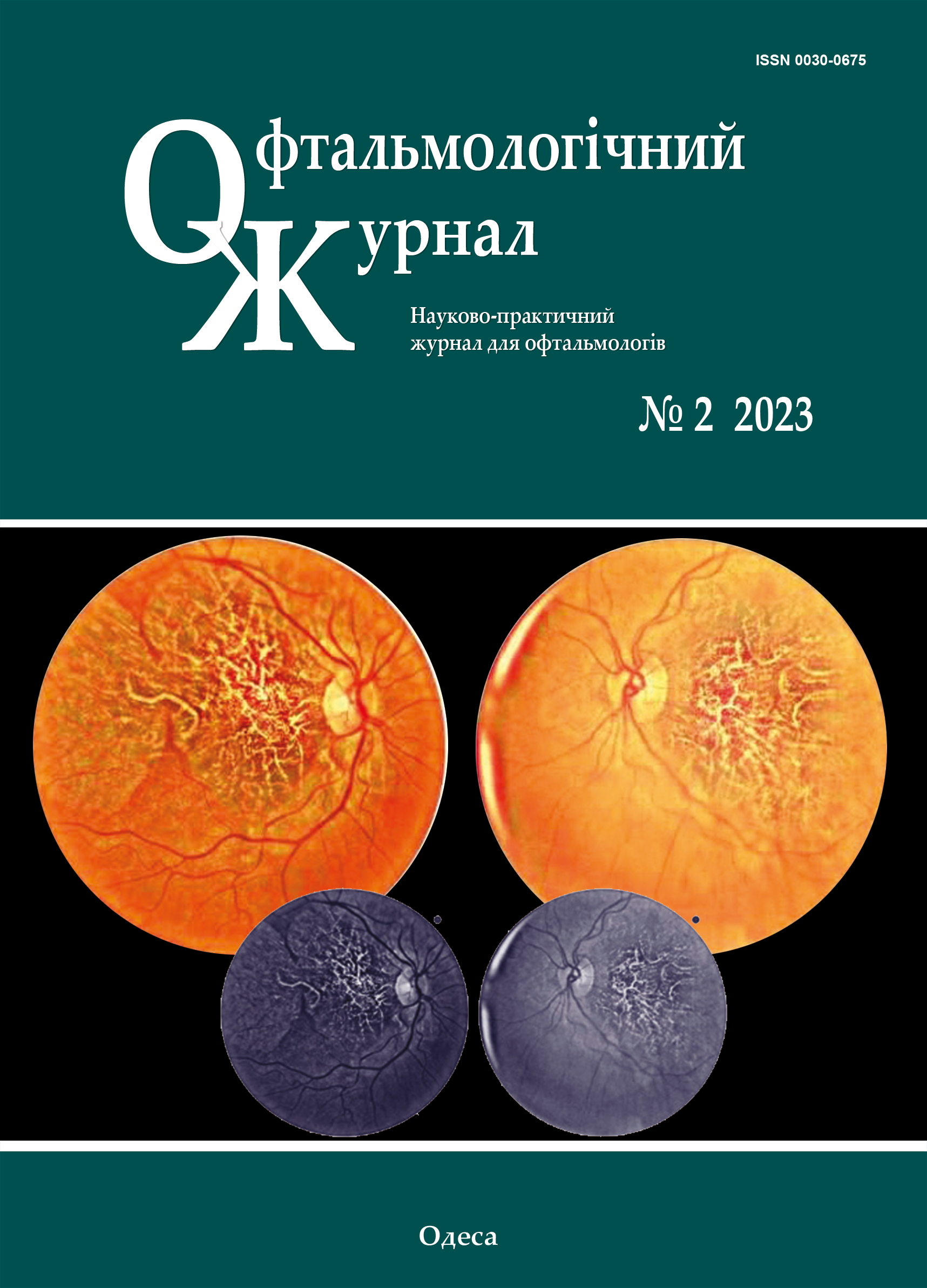Effect of tear osmolarity on postoperative refractive error after cataract surgery
DOI:
https://doi.org/10.31288/oftalmolzh202321115Ключові слова:
tear osmolarity, dry eye disease, cataract surgery, refractive errorАнотація
Purpose: To analyze the effects of tear osmolarity on postoperative refractive error and patient satisfaction after cataract surgery.
Methods: The patients were divided into two groups based on the tear osmolarity (group Nr 1-normal tear osmolarity, <310 mOsm/L; group Nr 2-hyperosmolar, >310 mOsm/L). Preoperative and postoperative (1 month after surgery) visual acuities (VAs), refractions, and best corrected VAs (BCVAs) were measured. The postoperative refractive error was measured as the spherical equivalent (SE) (SE = sphere + [0.5 × cylinder]). The postoperative VA, BCVA, and SE were compared between groups.
Results: Eighty-one patients were included in the study (group Nr 1=40 patients and group Nr 2=41 patients). The hyperosmolar group had a statistically significant higher postoperative refractive error (p<0.01, mean SE for group Nr 1=0.284; mean SE for group Nr 2=0.604) and lower VA after surgery (p<0.01, mean VA for group Nr 1=0.891; mean VA for group Nr 2=0.762).
Conclusions: Increased tear osmolarity can affect the planned outcome of cataract surgery as an unexpected refractive error. Measuring tear osmolarity before routine cataract surgery would help achieve accurate results and improve postoperative patient satisfaction.
Посилання
Ang RET, Quinto MMS, Cruz EM, Rivera MCR, Martinez GHA. Comparison of clinical outcomes between femtosecond laser-assisted versus conventional phacoemulsification. Eye Vis (Lond). 2018 Apr 23;5:8. https://doi.org/10.1186/s40662-018-0102-5
Davis G. The Evolution of Cataract Surgery. Mo Med. 2016;113(1):58-62.
Chen M. Refractive cataract surgery - what we were, what we are, and what we will be: A personal experience and perspective. Taiwan J Ophthalmol. 2019 Jan-Mar;9(1):1-3. https://doi.org/10.4103/tjo.tjo_133_18
Richard Lindstrom. Thoughts on Cataract Surgery: 2015. [cited 2022 Jun 17]. Available from: https://www.reviewofophthalmology.com/article/thoughts-on--cataract-surgery-2015.
Jin, S., & Lee, J. Refractive surgical corrective options after cataract surgery. Annals Of Eye Science. 2019; 4(3), 12. https://doi.org/10.21037/aes.2019.01.02
Kim K. Preoperative factors causing refractive errors after cataract surgery. Investigative Ophthalmology & Visual Science July 2019, Vol.60, 492.
Lundström M, Dickman M, Henry Y, Manning S, Rosen P, Tassignon MJ, et al. Risk factors for refractive error after cataract surgery: Analysis of 282 811 cataract extractions reported to the European Registry of Quality Outcomes for cataract and refractive surgery. J Cataract Refract Surg. 2018 Apr;44(4):447-452. https://doi.org/10.1016/j.jcrs.2018.01.031
Ladi, Jeevan S. Prevention and correction of residual refractive errors after cataract surgery. Journal of Clinical Ophthalmology and Research. 2017. 5. 45. https://doi.org/10.4103/2320-3897.195311
Lee AC, Qazi MA, Pepose JS. Biometry and intraocular lens power calculation. Curr Opin Ophthalmol. 2008 Jan;19(1):13-7. https://doi.org/10.1097/ICU.0b013e3282f1c5ad
Khan L, Sharma B, Gupta H, Rana R. Accuracy of biometry using automated and manual keratometry for intraocular lens power calculation. Taiwan J Ophthalmol. 2018 Apr-Jun;8(2):93-98. https://doi.org/10.4103/tjo.tjo_58_17
Turczynowska M, Koźlik-Nowakowska K, Gaca-Wysocka M, Grzybowski A. Effective Ocular Biometry and Intraocular Lens Power Calculation. European Ophthalmic Review, 2016;10(2):94-100 https://doi.org/10.17925/EOR.2016.10.02.94
Epitropoulos AT, Matossian C, Berdy GJ, Malhotra RP, Potvin R. Effect of tear osmolarity on repeatability of keratometry for cataract surgery planning. J Cataract Refract Surg. 2015 Aug;41(8):1672-7. https://doi.org/10.1016/j.jcrs.2015.01.016
Matossian S. How the tear film affects IOL measurements. Optometry Times Journal, August digital edition 2020, Volume 12, Issue 8. [cited 2022 Jun 17]. Available from: https://www.optometrytimes.com/view/how-the-tear-film-affects-iol-measurements.
Willcox MDP, Argüeso P, Georgiev GA, Holopainen JM, Laurie GW, Millar TJ, et al. TFOS DEWS II Tear Film Report. Ocul Surf. 2017 Jul;15(3):366-403. https://doi.org/10.1016/j.jtos.2017.03.006
Stapleton F, Alves M, Bunya VY, Jalbert I, Lekhanont K, Malet F, et al. TFOS DEWS II Epidemiology Report. Ocul Surf. 2017 Jul;15(3):334-365. https://doi.org/10.1016/j.jtos.2017.05.003
Gupta, Preeya, Drinkwater, Owen, VanDusen, Keith, et al. Prevalence of ocular surface dysfunction in patients presenting for cataract surgery evaluation. Journal of Cataract & Refractive Surgery. 2018 Sep. 44(9):p 1090-1096. https://doi.org/10.1016/j.jcrs.2018.06.026
Naderi K, Gormley J, O'Brart D. Cataract surgery and dry eye disease: A review. Eur J Ophthalmol. 2020 Sep;30(5):840-855. https://doi.org/10.1177/1120672120929958
Chien KJ, Horng CT, Huang YS, Hsieh YH, Wang CJ, Yang JS, et al. Effects of Lycium barbarum (goji berry) on dry eye disease in rats. Mol Med Rep. 2018 Jan;17(1):809-818. https://doi.org/10.3892/mmr.2017.7947
Massof RW, McDonnell PJ. Latent dry eye disease state variable. Invest Ophthalmol Vis Sci. 2012 Apr 6;53(4):1905-16. https://doi.org/10.1167/iovs.11-7768
Tomlinson A, Khanal S, Ramaesh K, Diaper C, McFadyen A. Tear film osmolarity: determination of a referent for dry eye diagnosis. Invest Ophthalmol Vis Sci. 2006 Oct;47(10):4309-15. https://doi.org/10.1167/iovs.05-1504
Lemp MA, Bron AJ, Baudouin C, Benítez Del Castillo JM, Geffen D, Tauber J, et al. Tear osmolarity in the diagnosis and management of dry eye disease. Am J Ophthalmol. 2011 May;151(5):792-798. https://doi.org/10.1016/j.ajo.2010.10.032
Hiraoka T, Asano H, Ogami T, Nakano S, Okamoto Y, Yamada Y, et al. Influence of Dry Eye Disease on the Measurement Repeatability of Corneal Curvature Radius and Axial Length in Patients with Cataract. J Clin Med. 2022 Jan 28;11(3):710. https://doi.org/10.3390/jcm11030710
Kim J., Kim M.K., Ha Y., Dong H.K. Improved accuracy of intraocular lens power calculation by preoperative management of dry eye disease. BMC Ophthalmol 21, 364 (2021). https://doi.org/10.1186/s12886-021-02129-5
PotvinR, Makari S, Rapuano CJ. Tear film osmolarity and dry eye disease: a review of the literature. Clin Ophthalmol. 2015 Nov 2;9:2039-47. https://doi.org/10.2147/OPTH.S95242
Ubeid AMR. The Unsatisfied Patient after Cataract Surgery Ocular Surface Disease as a Major Contributor. Int J Ophthalmol Clin Res 5:095.
Siew L, Tong L. The Effect of Past Cataract Surgery within the Medium to Long-Term Period on Patients with Dry Eye Disease. J Clin Med. 2022 Feb 13;11(4):972. https://doi.org/10.3390/jcm11040972
Szakáts I, Sebestyén M, Tóth É, Purebl G. Dry Eye Symptoms, Patient-Reported Visual Functioning, and Health Anxiety Influencing Patient Satisfaction After Cataract Surgery. Curr Eye Res. 2017 Jun;42(6):832-836. https://doi.org/10.1080/02713683.2016.1262429
Miura, M., Inomata, T., Nakamura, M,Sung, J., Nagino, K., Midorikawa- Inomata, A, et al. Prevalence and Characteristics of Dry Eye Disease After Cataract Surgery: A Systematic Review and Meta-Analysis. Ophthalmol Ther 11, 1309-1332 (2022). https://doi.org/10.1007/s40123-022-00513-y
Elksnis Ē, Lāce I, Laganovska G, Erts R. Tear osmolarity after cataract surgery. J Curr Ophthalmol. 2018 Sep 24;31(1):31-35. https://doi.org/10.1016/j.joco.2018.08.006
Sajnani R, Raia S, Gibbons A, Chang V, Karp CL, Sarantopoulos CD, et al. Epidemiology of Persistent Postsurgical Pain Manifesting as Dry Eye-Like Symptoms After Cataract Surgery. Cornea. 2018 Dec;37(12):1535-1541. https://doi.org/10.1097/ICO.0000000000001741
Taylor HR, Vu HTV, Keeffe JE. Visual Acuity Thresholds for Cataract Surgery and the Changing Australian Population. Arch Ophthalmol. 2006;124(12):1750-1753. https://doi.org/10.1001/archopht.124.12.1750
Chen Z, Lin X, Qu B, Gao W, Zuo Y, Peng W, et al. Preoperative Expectations and Postoperative Outcomes of Visual Functioning among Cataract Patients in Urban Southern China. Plos One. 2017 Jan. https://doi.org/10.1371/journal.pone.0169844
Xu, C. Successful Premium Multifocal IOL Surgery: Key Issues and Pearls. Current Cataract Surgical Techniques. London: IntechOpen; 2021 [cited 2023 Jan 02]. Available from: https://www.intechopen.com/chapters/75474 https://doi.org/10.5772/intechopen.96182
##submission.downloads##
Опубліковано
Як цитувати
Номер
Розділ
Ліцензія
Авторське право (c) 2023 Anete Kursite, Guna Laganovska

Ця робота ліцензується відповідно до Creative Commons Attribution 4.0 International License.
Ця робота ліцензується відповідно до ліцензії Creative Commons Attribution 4.0 International (CC BY). Ця ліцензія дозволяє повторно використовувати, поширювати, переробляти, адаптувати та будувати на основі матеріалу на будь-якому носії або в будь-якому форматі за умови обов'язкового посилання на авторів робіт і первинну публікацію у цьому журналі. Ліцензія дозволяє комерційне використання.
ПОЛОЖЕННЯ ПРО АВТОРСЬКІ ПРАВА
Автори, які подають матеріали до цього журналу, погоджуються з наступними положеннями:
- Автори отримують право на авторство своєї роботи одразу після її публікації та назавжди зберігають це право за собою без жодних обмежень.
- Дата початку дії авторського права на статтю відповідає даті публікації випуску, до якого вона включена.
ПОЛІТИКА ДЕПОНУВАННЯ
- Редакція журналу заохочує розміщення авторами рукопису статті в мережі Інтернет (наприклад, у сховищах установ або на особистих веб-сайтах), оскільки це сприяє виникненню продуктивної наукової дискусії та позитивно позначається на оперативності і динаміці цитування.
- Автори мають право укладати самостійні додаткові угоди щодо неексклюзивного розповсюдження статті у тому вигляді, в якому вона була опублікована цим журналом за умови збереження посилання на первинну публікацію у цьому журналі.
- Дозволяється самоархівування постпринтів (версій рукописів, схвалених до друку в процесі рецензування) під час їх редакційного опрацювання або опублікованих видавцем PDF-версій.
- Самоархівування препринтів (версій рукописів до рецензування) не дозволяється.












